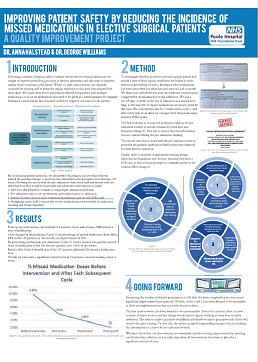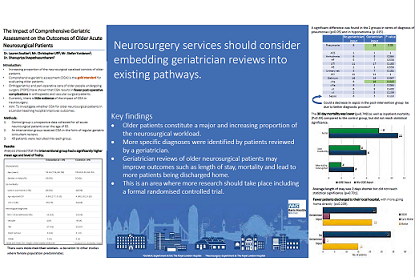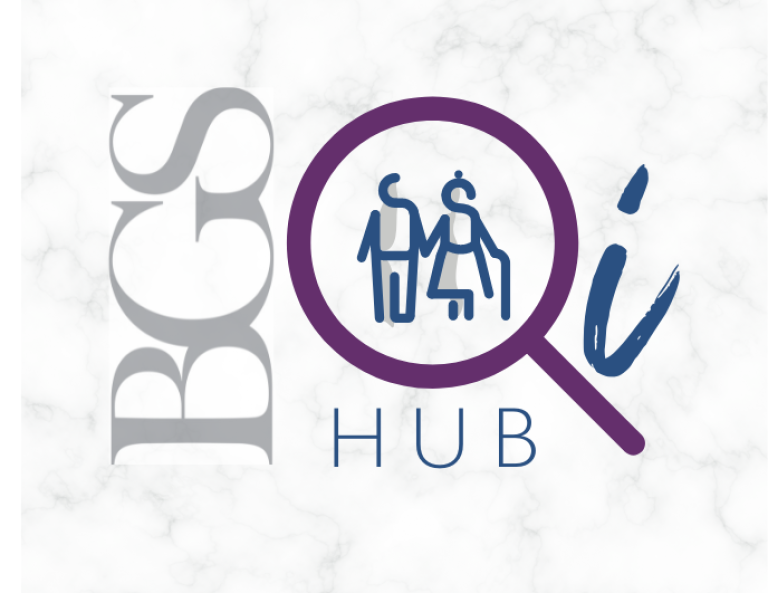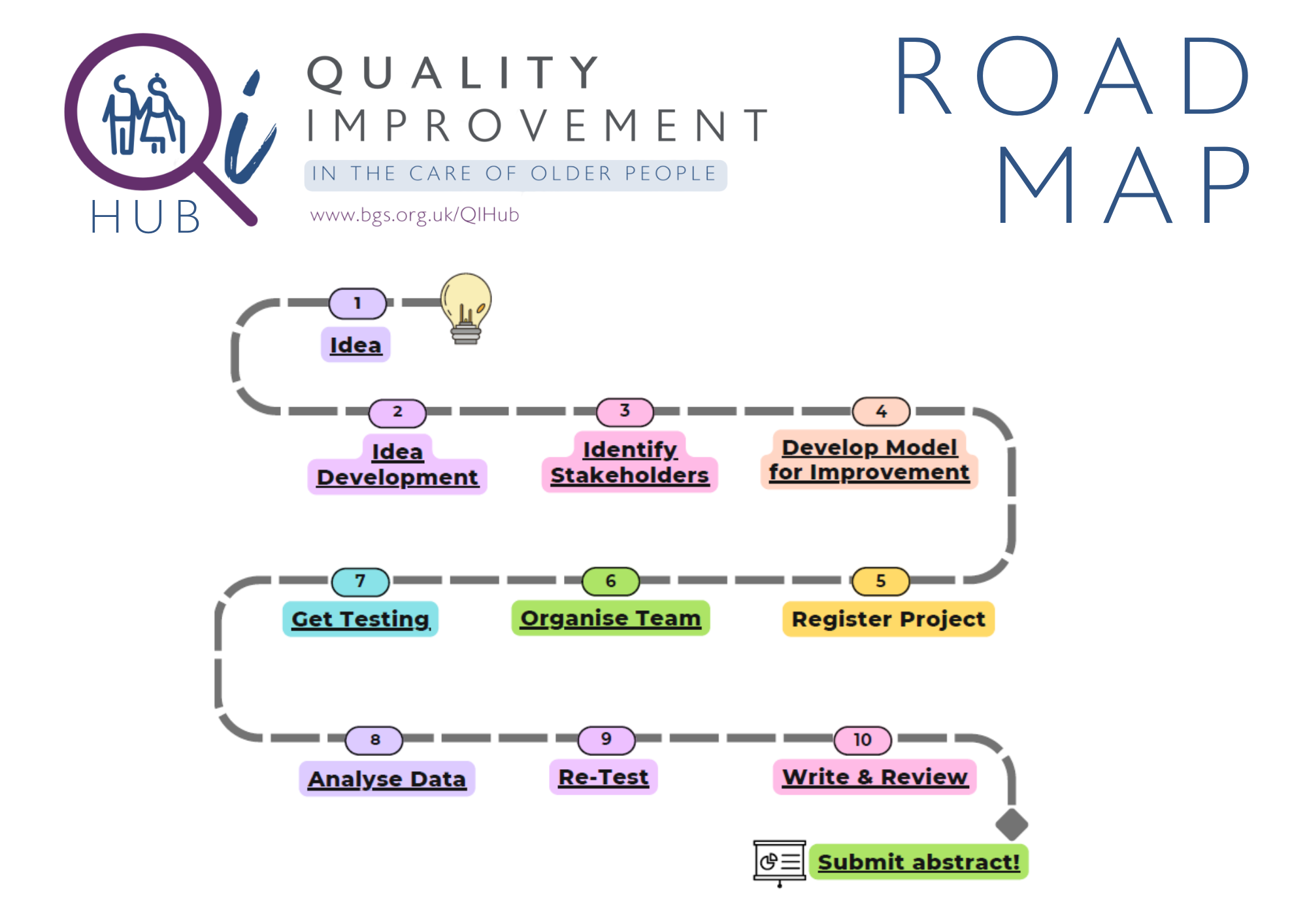QI Hub: Project ideas
This section provides hints and tips for quality improvement projects that relate to the health and care of older people, with real examples from abstracts and posters submitted to BGS conferences.
Ideas for QI projects relevant to older people
If you are struggling for ideas about where to start on your Quality Improvement journey, below are a few suggestions to get you started. We hope the ideas below act as a springboard for your project - and if in doubt, speak to your team!
|
Preventing harm |
Patient Safety |
Implementing best practice |
Working with patients and carers |
|---|---|---|---|
|
Preventing Constipation |
Falls Risk Assessment |
Introducing Comprehensive Geriatric Assessments |
Advance Care Planning |
|
Contracture prevention |
Fragility Fractures: Risk assessment and management |
Identifying Delirium |
Understanding and Reducing Carer Stress |
|
Fluid intake and restriction |
Improving Medication compliance: e.g. Reducing missed medications on chart |
Dementia Care: Referral to CNS, Carer Passports |
Correcting sensory impairment: Hearing aids, glasses etc. |
|
Diarrhoea: Managing Infection vs. Overflow |
Pain assessment and management |
Mood assessment and treatment |
DVLA Driving Advice |
|
Incontinence: Managing Urinary and Faecal incontinence |
Postural Hypotension |
Parkinson’s: e.g Inpatient CNS review, medication timing |
Planning for End-of-Life Care |
|
Nutrition assessment: MUST, Food & Fluid charts |
Perioperative anticoagulation |
Safe Sedative use: Z-Drugs, sedatives, benzodiazepine, |
Providing Family Updates |
|
Improving and maintaining Oral health |
Treatment Escalation Plans |
|
Preventing PJ Paralysis |
|
Assessing and reducing Polypharmacy |
Reducing opiate use |
|
Sleep |
|
Preventing Pressure sores |
Improving Communication and hand-over |
|
Improving Communications |
Writing and presenting an abstract
A great way of spreading you work is to present it at a conference. An abstract gives a concise overview of your project, your important results and interventions and can inspire others to followup or do similar projects.
Writing an abstract may seem challenging. In this section of the Hub we have picked out some examples of excellent abstracts and posters from the 2021 BGS Spring and Autumn meetings to provide some inspiration, and to demonstrate how to write and abstract and present a poster.
The BGS abstract submission guidelines can be found here, and information on preparing a virtual poster can be found here.
Example posters
Example 1
Improving patient safety by reducing the incidence of missed medications in elective surgical patients – Dr Anna Halstead and Dr George Williams
This was one of the top scoring abstracts from the BGS Spring Meeting 2021 and the poster is equally as good. It has a clear layout with introduction, methods, results and next steps distinctly demonstrated.
What is important about a poster is getting the key messages across clearly and quickly – the graph in the bottom left corner of this poster does this. It demonstrates the progressive reduction in missed medications with advancing PDSA cycles. This poster also has eye-catching infographic demonstrating their three PDSA cycles.
Example 2
Example 3
Example abstracts
Example abstracts
Example 1
|
Improving Advance Care Planning discussions and communication with primary care in geriatric medicine in a district general – M Twigg, D Robins-Piotrowski, R Jenkin
Introduction: Advance care planning and Respect forms are useful tools in the care of patients in geriatric medicine. Prior projects locally in acute medicine identified gaps in engaging appropriate patients in advance care planning. This quality improvement project aims to improve the identification and completion of Respect forms and how this information is passed on to primary care. NICEQS13 states there must be evidence to support conversations and care planning with relevant care agencies to ensure coordinated care. Methods: The Supportive and Palliative Care Indicator Tool (SPICT) was utilised to identify patients who would benefit from RESPECT forms. Patient notes were reviewed prospectively to see if RESPECT forms were completed during admission and discharge summaries assessed to determine whether RESPECT information was included and communicated to primary care. Following PDSA cycle 1 the medical team were provided with structured education in advance care planning and importance of communicating RESPECT forms to primary care. Reminder notes were attached to all computer work stations as an aid memoire when completing discharge summaries. Following cycle 2 there was a change of staffing and RESPECT form communication was included in the induction pack alongside further informal ward based teaching.
Results: Identification of patients needing advance care planning improved from 80% to 100% of these patients being discharged with Respect forms. In the initial data collection 8% of Respect forms were communicated to primary care. This improved to 96% by the third cycle with sustained improvement across junior doctor rotations.
Conclusion: A sustained education program for geriatric medicine staff led to an increase in communication of advance care planning to GP’s. The NICE QS13 standards have been met and the Method:ology will be transferrable to other departments in the hospital. A more integrated platform with primary care would help improve communication with primary care further.
|
This abstract from the BGS Autum Meeting 2021 begins by clearly defining the problem that their project targets.
It focuses on a relevant and important topic to geriatric medicine. There is also reference to relevant national guidance. The methods section defines two PDSA cycles demonstrating understanding and utilisation of QI methodology.
Numerical data is demonstrated in the results section giving an overview of the key results without being overwhelming with numbers.
Finally the conclusion gives a brief summary of the project and an idea for future improvement work.
Example 2
|
Introducing Treatment Escalation Plans (TEP) for older persons: Response to the COVID-19 pandemic – SJ Woolford, HP Patel
Introduction: TEP detail appropriate ceilings of care and guide treatment of patients based on shared decision making. TEP documentation was not standard within our trust up to 2018. We aimed to design and introduce a standardised TEP proforma and evaluate its use in older persons aged ≥80.
Methods: Data was obtained from patient notes and questionnaires within the Medicine for Older Persons department (MOP) from four PDSA cycles between 2018-2020. Cycle 1 was a service evaluation. Based on this data, a TEP form was created and approved for use in all adult patients. Cycles 2, 3 and 4 evaluated TEP after Introduction: of the proforma.
Results: There was a 239% increase in TEP after Introduction: of the proforma, compared to baseline (cycle 1: n=14/47 [29.8%], cycle 2: n=17/112 [15.2%], cycle 3: n=30/97 [30.9%], cycle 4: n=42/59 [71.2%]). The increase in TEP between cycles 3 and 4 coincided with the COVID-19 epidemic. Clinicians were more confident in actioning TEP based on the proforma, compared to those written in the notes (cycle 2: 83% confidence vs 54%, cycle 3: 100% vs 35%, Cycle 4: 98% vs none written in the notes). An improvement in understanding the purpose, comprehensiveness and location of TEP forms was observed. Feedback suggested TEP provided clear guidance for 1. ceilings of care; especially useful out of hours 2. discussions with critical care and 3. patient handover between staff and successive shifts.
Conclusion: TEP forms offer clear guidance on ceilings of care. Introduction: of the TEP proforma has led to more frequent and proactive discussions with patients on ceilings of care and have facilitated a culture change in the management of older persons. Use of the forms increased during the COVID-19 pandemic but are now viewed as an essential component of patient safety and have been successfully implemented trustwide.
|
This abstract, also from the BGS Autumn Meeting 2021, again reviews a project that is of interest and relevance to current geriatric medicine.
The aim of the project is clearly defined. The methods and results sections define four PDSA cycles and given numerical data to allow comparison.
This abstract is reviewed in more detail in a recent article in the BGS newsletter here.





